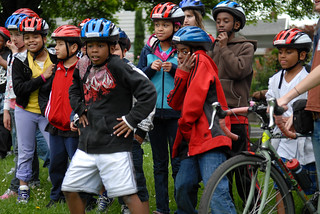
Other cities will get regional funding
for the programs thanks to new Metro grants.
(Photo: J.Maus/BikePortland)
With the federal government’s support for early biking education shrinking, the Portland area’s regional government is making a significant investment.
Safe Routes to School programs in Tigard, Beaverton and across the region are among the winners of $2.1 million in Metro grants announced Monday. Other highlights include a new active transportation staffer for Portland Community College, a bicycle tourism initiative in the Gresham area and continued support for the City of Portland’s marketing of biking, walking and public transit.
The $2.1 million in two-year grants were chosen from among $4.6 million requested by various nonprofits and government agencies around the region.
Monday’s official award announcement comes amid concerns about Metro’s decision, with this grant cycle, to eliminate funding for the city’s three transportation management associations. As we reported Saturday, this decision is likely to result in the closure of the Swan Island TMA, a two-person nonprofit that has played a major role in improving non-car transportation options to the inner North Portland industrial area.
“Metro sent a clear message. Sea change time.”
— Swan Island TMA Director Sarah Angell on changes to Metro grant recipients
This grant cycle’s cuts to the Swan Island, Lloyd District and Washington Park TMAs followed a trend from previous cycles to pull back on funding small transportation-focused groups in order to support organizations with multiple missions.
In 2013 and again this month, Metro denied grant requests from South Waterfront Community Relations to fund low-car transportation efforts in that neighborhood. In previous years, Metro had eliminated funding for similar programs in Clackamas County and Gresham.
One TMA did receive funding this year: the Westside Transportation Alliance, which the Washington County government shielded from any cuts. The City of Portland, which this year was again the largest single recipient of the program’s funds, did not make any such requests on behalf of any projects within its borders.
Washington TMA Executive Director Jenny Cadigan wrote on Friday that she was “shocked to be honest” by Metro’s decision not to renew funding for other TMAs. “It makes me even more grateful to have been awarded funds,” she added.
“Metro sent a clear message,” wrote Swan Island TMA Executive Director Sarah Angell. “Sea change time.”
Advertisement
Despite the strong opinions related to the proposed elimination of TMA funding, there’s a lot to like in this project list, which is probably the biggest single source of active transportation program funding in the region. We’re certain to cover many of these projects as they have effects over the next two years.
For example, here’s Metro’s description of the PCC grant:
One of the new grantees is Portland Community College, which will use a $157,000 grant to hire a district-wide active transportation coordinator, install dozens of secure bicycle lockers at its Southeast and Cascade campuses and hold events and workshops to help students and staff learn how to safely walk and bike to class and work.
In previous cycles, the program generally hasn’t been used to pay for infrastructure. But that has changed this year, as Metro writes:
Also new to this cycle’s travel options grants are awards for light infrastructure, such as bike parking, on-road directional and use markings like sharrows and planning grants for local jurisdictions to kickstart implementation of local efforts to improve travel options for residents and commuters. Funded projects will provide easier navigation for pedestrians in Washington Park, fill a key bikeway gap in Gresham’s Rockwood neighborhood, build bike shelters in Aloha and support planning for expanded travel choices in Washington County.
Here’s the full list of winners:
- Portland Bureau of Transportation: Active Portland – Open Streets, Connected Communities, $465,000
- Ride Connection: RideWise Urban Mobility Support and Training, $222,233
- Westside Transportation Alliance: Westside Transportation Demand Management, $203,500
- Beaverton School District: Safe Routes to School Program, $158,000
- Portland Community College: Transportation Demand Management Coordinator and Bicycle Improvements, $156,822
- Bicycle Transportation Alliance: Expanding Access to Bicycling, $155,040
- City of Tigard: Safe Routes to School Coordinator, $150,000
- Portland Public Schools: Healthy Travel Options to School, $125,000
- Verde: Living Cully Walks, Phase 2, $102,127
- Clackamas Community College: Student Transportation Initiative, $85,018
- City of Gresham: Gresham Sharrows, $63,260
- Washington County: Washington County Travel Options Planning, $50,000
- West Columbia Gorge Chamber of Commerce: Gorge Hubs and Business Outreach, $50,000
- Gresham Chamber of Commerce: East Multnomah County Bicycle Tourism Initiative, $50,000
- National Safe Routes to School Alliance: Regional Safe Routes to School Planning, $25,000
- Housing Authority of Washington County: Aloha Park Bike Shelters, $15,000
- City of Lake Oswego: Active Transportation Counters, $14,000
- Washington Park Transportation Management Association: Transit to Trails Wayfinding, $10,000






Thanks for reading.
BikePortland has served this community with independent community journalism since 2005. We rely on subscriptions from readers like you to survive. Your financial support is vital in keeping this valuable resource alive and well.
Please subscribe today to strengthen and expand our work.
While it’s nice that Metro is funding infrastructure this year, they should fund protected bike lanes instead of sharrows.
I think the City of Portland’s broad-based active transportation program is less-effective and far more expensive than needed. I have yet to see evidence that type of program produces long-term results.
I’d rather the $465,000 was spent on rapid flash beacons at key locations.
Any metrics that you value that you wish to share?
Yes. How do the expenditures in individual program areas (individualized marketing, general marketing, etc.) actually translate into long-term (or even short-term) changes in mode share? I want some verifiable, statistically valid surveys, not just feel good stories. We’re talking about big money being spent on staff time. I’d like to see more permanent installations like the rapid flash beacons that are proven to improve motorist compliance at crosswalks.
I think the statistics you are looking for are available here: https://www.portlandoregon.gov/transportation/article/515317
Also, keep in mind that effective safe routes to school programs are paired with infrastructure improvements that make biking and walking safer. The programs teach kids how to use the infrastructure and encourage them and their families to choose active transportation.
Also, kids come and go from local schools, just like residents come and go from and within portland. Parents have to be (re)taught each school’s transportation plan at the beginning of every school year. PBOT targets residents that have recently moved because studies show those that recently made a change are most open to making other changes.
Portland Smart Trips, including past outreach reports:
https://www.portlandoregon.gov/transportation/43801
Thanks for the links, but the evidence does not persuade me as to the effectiveness of the programs. My skepticism has to do with the small sample size and the self-selected nature of the reporting. I’ve seen too many “studies” by the recipients of the funds that were statistically and methodologically flawed. I want to see some peer-reviewed studies that show real results.
This needs to help build the future Red Electric Trail in SW Portland.
Agreed. The potential shared use trail system in SW is the best option for that topography. I think it is just too creative/edgy/risky for PBOT to consider.
Correction – There is not a total of 4.6 million available to non profits and government agencies. There is only 2.1 million over two years. The other 2.5 million is taken by some staff at Metro. Love that equity!
The $4.6 million is the total requested, not the total funding. It’s several hundred thousand off the top to Metro (and I believe to TriMet?) but nowhere close to $2.5 million.
Where might one find descriptions of the other funded items?
Is it weird to anyone else that PBOT is eligible for these types of grants?
It kind of seems like PBOT should be GIVING out these types of grants.
PBOT should be funding stuff in Beaverton, or the Gorge?
In Portland at least.
Do you think they should be getting funding from these types of grants?
As the residents of Portland contribute to the funding pool from which these grants are provided, most certainly Portland residents should benefit.
That wasn’t exactly the question. I was asking should PBOT be eligible for these grants? And there are plenty of other non-profit-type groups in Portland that could use these funds.
PBOT should be pitching in to fund the Swan Island TMA! Also at the Port of Portland, one of the largest property owners on Swan Island
I meant: Also, the Port of Portland should pitch in to help fund TDM (Transportation Demand Management) on Swan Island.